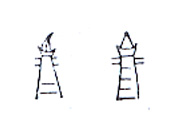The suit is unique and surprisingly intact for being in the ground since before the Greek Dark age.
However, it seems to have been well known enough to allegedly have ideograms of it from two sites:
Knossos

Pylos

So it was known during the period it was supposedly used but no one has any ideas of what its exact purpose was. So its kinda a LS type situation where it existed and there are representations and permutations of it but its still kinda a unicorn.
http://www.salimbeti.com/micenei/armour1.htm







 Reply With Quote
Reply With Quote
Bookmarks